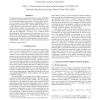115 search results - page 14 / 23 » Discriminative simplification of mixture models |
ICASSP
2008
IEEE
14 years 1 months ago
2008
IEEE
In many pattern recognition tasks, given some input data and a family of models, the “best” model is defined as the one which maximizes the likelihood of the data given the m...
ICMCS
2006
IEEE
14 years 23 days ago
2006
IEEE
In this paper, we propose a probabilistic model for web image mining, which is based on concept-sensitive salient regions without human intervene. Our goal is to achieve a middle-...
EMNLP
2007
13 years 8 months ago
2007
This paper presents a syntax-driven approach to question answering, specifically the answer-sentence selection problem for short-answer questions. Rather than using syntactic fea...
ICASSP
2011
IEEE
12 years 10 months ago
2011
IEEE
We introduce Bayesian sensing hidden Markov models (BS-HMMs) to represent speech data based on a set of state-dependent basis vectors. By incorporating the prior density of sensin...
AVSS
2009
IEEE
13 years 10 months ago
2009
IEEE
—Automatic understanding of human behavior is an important and challenging objective in several surveillance applications. One of the main problems of this task consists in accur...

